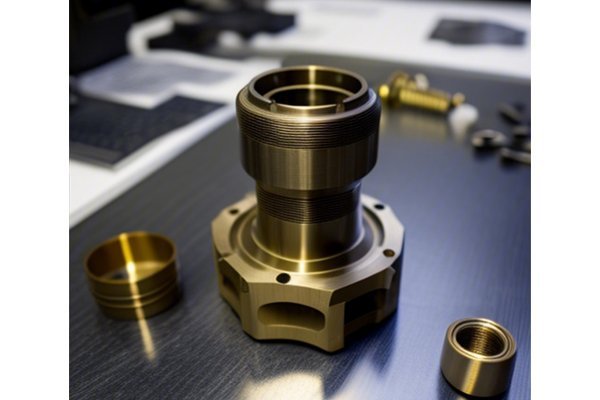Did you know that stainless steel accounted for approximately 70 million metric tons of global production in 2020? Among the numerous grades of stainless steel, 347 stainless steel is particularly prized for its corrosion resistance and excellent high-temperature mechanical properties. However, machining materials like 347 stainless steel using CNC (Computer Numerical Control) processing can be a challenging endeavor due to its toughness and the potential for tool wear. This blog aims to shed light on the various techniques and best practices to improve cutting efficiency in CNC processing of this specific grade of stainless steel.
Understanding 347 Stainless Steel
What is 347 Stainless Steel?

347 stainless steel is a stabilized austenitic grade designed for high-temperature applications. It contains columbium (niobium) which stabilizes the alloy, minimizing the formation of chromium carbides that can lead to sensitization and, consequently, reduced corrosion resistance. This makes it ideal for applications in the chemical and petrochemical industries, jet engines, and furnace applications.
Properties of 347 Stainless Steel
347 stainless steel boasts several essential properties:

Challenges in CNC Machining 347 Stainless Steel
Despite its favorable properties, machining 347 stainless steel presents several challenges:
Strategies to Improve Cutting Efficiency
Improving cutting efficiency in CNC machining requires a multi-faceted approach involving tooling, machining parameters, and process optimization. Here are some effective strategies:
a. Material Composition
Choosing the right cutting tool material is crucial. Tools made from carbide, ceramic, or coated carbide are often optimal for machining 347 stainless steel. The following tool types are recommended:
b. Geometry
Utilizing appropriate tool geometry can significantly influence efficiency:
a. Speed and Feed Rate
The optimal cutting speed (SFM) for 347 stainless steel typically falls in the range of 100-150 SFM. However, this can vary based on tool material, geometry, and machine capabilities. Maintaining an appropriate feed rate (IPM) is also essential. 0.005 to 0.012 inch/rev is generally acceptable, but adjustments may be necessary based on real-time performance.
b. Depth of Cut

Maintaining an appropriate depth of cut (DOC) is vital for balancing efficiency and tool life. Shallow depths can lead to excessive tool wear, while too deep cuts can induce tool failure. A DOC of 0.020 to 0.100 inch is a good starting point.
a. Use of Coolants
Employing self-cooling techniques or using lubricants can help mitigate heat and extend tool life. Water-based coolants are effective, but using oils or synthetic coolants may offer considerable heat dissipation and lubricating properties.
b. Minimum Quantity Lubrication (MQL)
For environments where excessive coolant isn’t viable, MQL can be a game changer. A mist of lubricant is sprayed onto the cutting surface, effectively reducing heat and allowing for better control of chip formation.
Having effective chip control strategies in place can greatly enhance productivity. Here’s how:
a. Using Chip Breakers
Incorporate chip-breaking features in your tools:
b. Chip Holes and Segmented Tools
Using tools with built-in chip holes or segmented designs can encourage optimal chip flow, thereby reducing entanglements.
a. Machine Calibration
Ensure that your CNC machine is adequately calibrated. Regular checks on alignment and backlash can avoid inaccuracies during machining.
b. Tool Path Optimization
Optimize the CNC tool path to minimize unnecessary movement and ensure the tool spends the maximum amount of time cutting and the least time traveling. Advanced software can simulate and optimize tool paths automatically.
Regular monitoring and review of tool wear can help in achieving consistent cutting efficiency. Early detection of wear can prevent catastrophic tool failure and increase overall productivity.
a. Using Sensors
Consider implementing smart sensors that provide real-time data on tool condition, enabling immediate adjustments when necessary.
a. Skill Development
Regularly train your CNC operators on best practices for tool handling, machine settings, and troubleshooting techniques. Knowledgeable and skilled operators can significantly enhance cutting efficiency.
b. Lean Manufacturing Principles
Incorporate lean practices that streamline processes and reduce waste.
Improving cutting efficiency in CNC processing of 347 stainless steel is not merely about selecting the right tools; it encompasses a holistic approach involving meticulous planning, tool selection, process optimization, and continuous monitoring. Each aspect, from the choice of coolant to the operator’s skill level, plays a critical role in achieving optimum results.
By employing the strategies outlined in this blog, you can enhance the performance of your CNC machining operations, reduce costs associated with tool changes and downtime, and ultimately deliver higher quality parts to your customers. As industries increasingly lean into automated and precise manufacturing processes, understanding how to efficiently work with tough materials like 347 stainless steel becomes paramount.
It’s essential to embrace ongoing learning and adjustment as technology evolves, ensuring that your processes remain cutting-edge. Remember, the key to success in CNC machining lies not just in the machines we use, but also in how intelligently we operate and adapt to the materials we work with.




